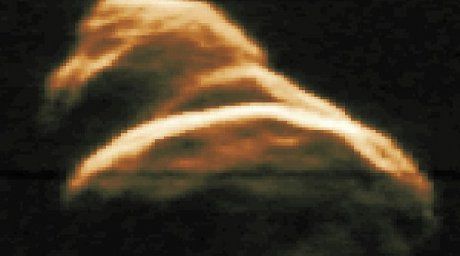 Radar shot of asteroid 4179 Toutatis made in 1992. Phot:NASA©Even scientists who are not inclined to believe in mysticism describe asteroid Tautatis, which will fly past our planet, as a possible harbinger of the end of the world.
Radar shot of asteroid 4179 Toutatis made in 1992. Phot:NASA©Even scientists who are not inclined to believe in mysticism describe asteroid Tautatis, which will fly past our planet, as a possible harbinger of the end of the world.
The asteroid is a peanut-shaped planetoid that measures 4.7 kilometers by 2.4 kilometers by 1.9 kilometer and will pass within 1.5 million kilometers of the Earth at a speed of 35,000 kilometers per hour.
The asteroid can be observed through strong binoculars or with an amateur telescope. According to Noviye Izvestia, the problems that have arisen with the coming of Tautatis are far more interesting. On its path through the solar system, Tautatis passes through the asteroid belt between Mars and Jupiter and passes near Earth's orbit once every four years.
In December 1992, the asteroid passed 3.6 million kilometers from Earth; on November 29, 1996, it came 5.3 million kilometers from Earth; in October 2000, it was 11 million kilometers from Earth and on September 29, 2004, it will be 1.5 million kilometers from Earth.
The last time Tautatis came so close to Earth was in 1353, and the next time it is expected to get so close is in 2562. "Its orbit is thoroughly calculated," assured Mikhail Smirnov, Ph.D. (Physics and Mathematics), from the astronomy department at the Institute of Astronomy, Russian Academy of Sciences. "Luckily, it is fairly stable and Tautatis presents no danger to the population of Earth.
The movement of other asteroids that are far more dangerous for humanity can be modeled based on the unique information that can be obtained by studying it." Over 500 such asteroids have been recorded and their number is growing. Though none of these asteroids will hit Earth in the next 200 years, there are about 500 more absolutely unknown objects in the solar system.
Tautatis is being studied to help identify these objects and search for ways to prevent a catastrophe. Today, there are several scenarios to prevent a collision. The main one is to destroy an approaching asteroid by firing a missile with a nuclear warhead at it. "This task can be performed by the Russian Soyuz and Proton rockets," Smirnov said.
"It would be far more interesting not to destroy the asteroid but to change its trajectory and put it on an orbit around Earth with a solar sail so that a space station could be built on such a satellite."
 В Атырау -6
В Атырау -6